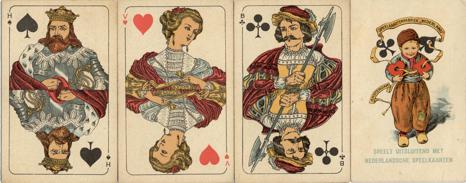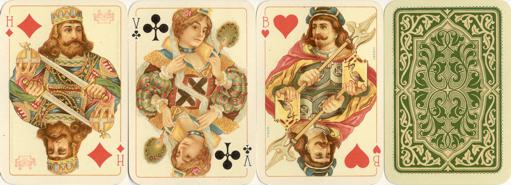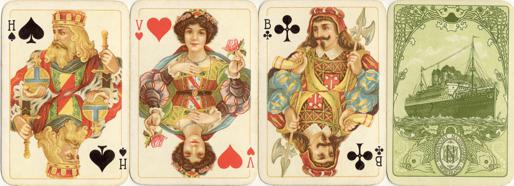 |
The "Export"
deck was originally printed around 1912 by the NSF, but published later
also by SN and various companies for advertising. It was in the pattern
books until 1935. The decks came in a paper wrapper. |
|
|
|
 |
The "Export"
deck was originally printed around 1912 by the NSF, but published later
also by SN and various companies for advertising. It was in the pattern
books until 1935. The decks came in a paper wrapper. |
|
|
|
|
Originally printed
and published as "Kroonkaart No 12" by NSF in 1911. In
the original NSF version the aces were plain, but the deck was later
also published by SN as "Nederlandse Kroonkaart". The courts have a
version of the Frankfurt pattern and scenic aces with views of the
palaces and castles that are owned by our royal family (shown here
below). It was in production until
1940. |
|
|
|
|
After
WW I the Speelkaartenfabriek Nederland kept growing. In 1919 the playing card
division was still making a profit, although the sales were dropping. In 1920
the turnover is even less. In 1920 the playing card tax is introduced in
Holland. Decks up to 32 cards are taxed with 25 cents and decks with more cards
are taxed with 50 cents. The period that taxes were imposed ended in 1927. In
1924-1925 the total tax turnover increased. More than half of this amount was
paid by SN. These years must have been good for the company.
 |
The "Fortuna" deck was made since 1915. The deck was also published as "Club", "Amstel" and "Schelde". It was printed in chromolithography and the number of used colours (print runs) determined the different versions. The deck usually comes with the above scenic aces showing 8 Dutch castles. There are known versions with 32, 40, 52 cards and 52+Joker. All versions were available from 1915 until 1942. The "Club" was in stock until 1944. |
|
|
|
 |
There are some special editions for shipping lines, that have specially designed aces. The NSM deck here comes with a set of scenic aces that depict the various ports across the world that the NSM line frequented. The
view of the Central Station in Amsterdam was probably the view from the
offices of the NSM line (Nederlandsche Stoomvaart Maatschappij = Dutch
Steamship Company) on the Piet Hendrikkade in Amsterdam. The other
scenes are from ports that this shipping line frequented, some from, for
those days, exotic places like Tanger, Singapore or Colombo. |
|
|
|